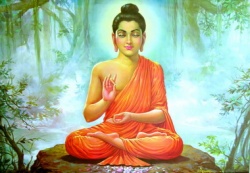Northward Bound by Arnie Kozak, Ph.D
Mahayana Buddhism was spreading northward from India as Theravada was spreading throughout the south and southeast. Vajrayana Buddhism headed north to Tibet and took a fast hold of that isolated mountainous country. Mahayana Buddhism proliferated in China, Japan, and Korea.
The Silk Road
Silk was a hot commodity in the ancient world, and in the second century C.E., a path developed across Asia that allowed the passage of silk from one country to another. This road, which came to be known as the Silk Road, was just north of India and west of Tibet. The 6,000-mile road traversed what would be Afghanistan, Pakistan, and northwestern China today. The Silk Road was a ferment of international trade that connected India to China. Silk went one way and gold and silver went the other. Early Chinese tradesmen started to hear of the wonderful teachings coming out of India, and curiosity in Buddhism was aroused in China. The first missionaries to China arrived in the first century C.E. They headed northward from India to spread the teachings of the Buddha. Literate Chinese started translating the sutras into Chinese and continued to do so for eight centuries.
Source
www.netplaces.com [[Category:Silk Road]]
